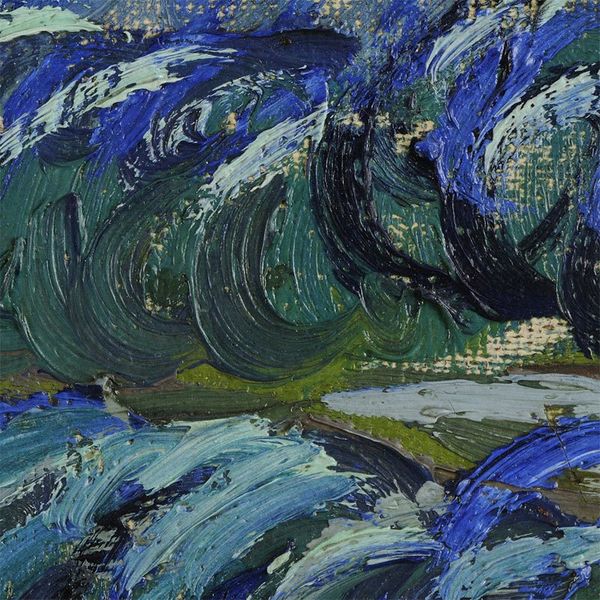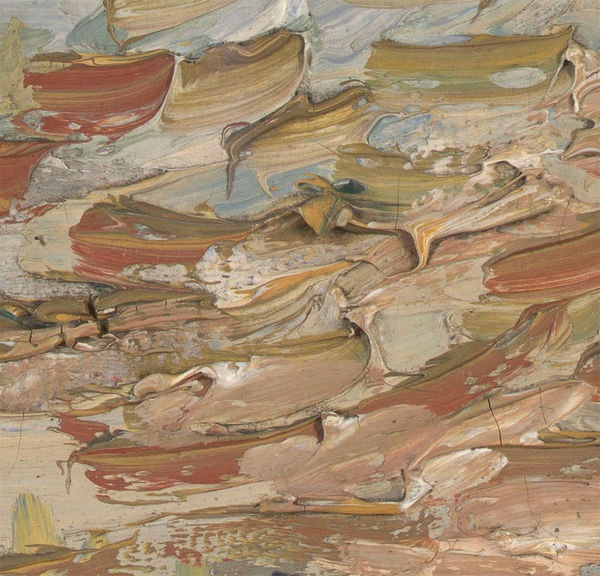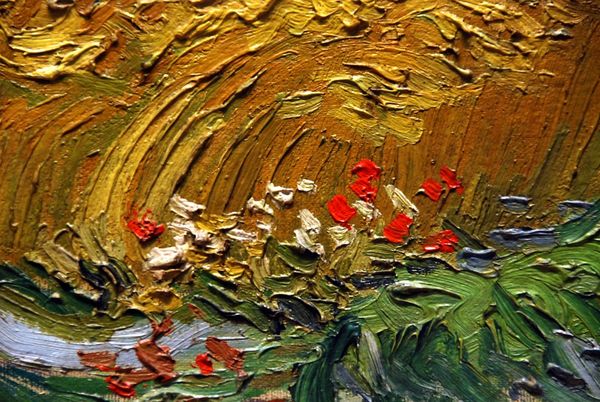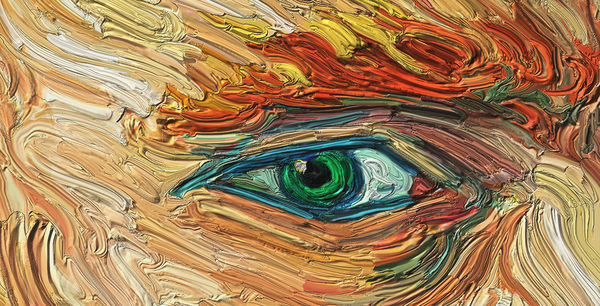Check out Printers and Color Printing Forum section of our forum.
Monthly Masters' Critique - March 2020 - Van Gogh's "Starry Night"
Mar 2, 2020 14:33:53 #
fergmark wrote:
Your magic bus is very cool Richard!
Thanks very much.
Mar 2, 2020 15:37:50 #
I have always thought Van Gogh paintings were very special. There is a unique energy in them. As one who has painted, I recognize that he actually mixed paint on the canvas as well as on his pallet. Painters as a rule avoid that because paint turns muddy quickly, but his paint is so thickly applied, and on top of wet paint, that there is no muddy result. I found a few closeups that illustrate the thickness of paint and colors mixing in several of his paintings.
starry night

wheat field with peasant

wheat field with cypresses

one of his self portraits

(Download)
Mar 2, 2020 15:59:04 #
fergmark wrote:
I have always thought Van Gogh paintings were very special. There is a unique energy in them. As one who has painted, I recognize that he actually mixed paint on the canvas as well as on his pallet. Painters as a rule avoid that because paint turns muddy quickly, but his paint is so thickly applied, and on top of wet paint, that there is no muddy result. I found a few closeups that illustrate the thickness of paint and colors mixing in several of his paintings.
Love the textures shown here.
Check out The Dynamics of Photographic Lighting section of our forum.
Mar 3, 2020 08:35:04 #
I join others in loving Richard's Magic Bus and wishing him all the best with his family's challenges.
Fun stuff from Dave and Don, very cool information with close-up examples from Mark.
Fun stuff from Dave and Don, very cool information with close-up examples from Mark.
Mar 3, 2020 08:41:27 #
fergmark wrote:
I have always thought Van Gogh paintings were very special. There is a unique energy in them. As one who has painted, I recognize that he actually mixed paint on the canvas as well as on his pallet. Painters as a rule avoid that because paint turns muddy quickly, but his paint is so thickly applied, and on top of wet paint, that there is no muddy result. I found a few closeups that illustrate the thickness of paint and colors mixing in several of his paintings.
Thanks for sharing your expertise!
Mar 3, 2020 09:24:20 #
Linda From Maine wrote:
I join others in loving Richard's Magic Bus and wishing him all the best with his family's challenges.
Fun stuff from Dave and Don, very cool information with close-up examples from Mark.
Fun stuff from Dave and Don, very cool information with close-up examples from Mark.
Thank you.
Mar 7, 2020 04:58:03 #
You ask us to comment on the possible symbolism of the various elements within the image. My opinion is that there's not much to be gained from contemplating that possibility because I believe that there isn't much in the way of symbolic meaning behind them. Vincent was known for his commitment to realism, and I suspect that his departures from strict realism don't go any further than him including elements that he knew could have been there even if they were actually absent. For example the cypress tree is unrealistic only in that there weren't any that close to his location. They were common in that area. The same could be said about the village, and while the church's spire isn't typical of the local architecture, its style is what he was familiar with because it was typical of the area where he grew up.
I suspect that the same observation applies to all of the elements within the scene. They were either immediately visible or they could have been. That suggests to me that the "could have been" elements were included as compositional elements and it would be a mistake to read much in the way of symbolic meaning into them.
As far as the swirly, wavy look is concerned, some say that it's a symptom of his troubled state of mind. My guess is that it was an attempt to impart something of the dynamism and energy that he sensed in what he saw. Creators of animations use similar techniques and I'm also reminded of the pulsating effect that some animators use (not identical but the same idea). Apparently when someone commented on how thickly Vincent applied paint to his paintings he explained that it's how he saw the colours. In other words he was using brushwork and the paint itself to convey something of the vividness that he experienced when viewing his subjects. I suspect the same thing applied to the dynamism that he perceived within his subjects.
IMO the symbolism isn't in what he includes but in how he portrays it.
You ask if photographers teach us to see. That seems a bit ambitious to me and if it applies at all it applies to the more artistic photographic styles such as abstract, impressionist and the like. However, I would agree that good photography encourages us to see, and there is much to be learned from considering how the viewer's attention can be caught and directed by good composition.
I suspect that the same observation applies to all of the elements within the scene. They were either immediately visible or they could have been. That suggests to me that the "could have been" elements were included as compositional elements and it would be a mistake to read much in the way of symbolic meaning into them.
As far as the swirly, wavy look is concerned, some say that it's a symptom of his troubled state of mind. My guess is that it was an attempt to impart something of the dynamism and energy that he sensed in what he saw. Creators of animations use similar techniques and I'm also reminded of the pulsating effect that some animators use (not identical but the same idea). Apparently when someone commented on how thickly Vincent applied paint to his paintings he explained that it's how he saw the colours. In other words he was using brushwork and the paint itself to convey something of the vividness that he experienced when viewing his subjects. I suspect the same thing applied to the dynamism that he perceived within his subjects.
IMO the symbolism isn't in what he includes but in how he portrays it.
You ask if photographers teach us to see. That seems a bit ambitious to me and if it applies at all it applies to the more artistic photographic styles such as abstract, impressionist and the like. However, I would agree that good photography encourages us to see, and there is much to be learned from considering how the viewer's attention can be caught and directed by good composition.
Check out Travel Photography - Tips and More section of our forum.
Mar 9, 2020 12:49:11 #
R.G. wrote:
You ask us to comment on the possible symbolism of... (show quote)
Thank you RG for a thorough assessment.
Interesting point you make: "IMO the symbolism isn't in what he includes but in how he portrays it." I find I agree with you.
I can only speak for myself on the question of "seeing". I do think I've become more attuned to details, colors, design since I took up photography as a hobby. I notice small things that I once overlooked, nuances of light and shadow and tone. Perhaps that is "baked in" with some people and photography allows them to express it, but perhaps others become more aware after looking through a lens for a while.
Mar 9, 2020 13:29:15 #
minniev wrote:
......I can only speak for myself on the question of "seeing". I do think I've become more attuned to details, colors, design since I took up photography as a hobby. I notice small things that I once overlooked, nuances of light and shadow and tone. Perhaps that is "baked in" with some people and photography allows them to express it, but perhaps others become more aware after looking through a lens for a while.
If your question was "Does practising photography teach us to see?" I would give a definite "Yes". To be more specific, it's being constantly on the lookout for photographic opportunities that teaches us to see. Once you get to the point where you have a fair idea of what works and what doesn't work, you become attuned to noticing the favourable signs (good lighting, good perspective etc). That could be extended to noticing those scenes and objects that have artistic potential and interest. A casual observer wouldn't dedicate anything like as much energy and attention into noticing these things. And it's through exercise that we develop that "eye".
Mar 9, 2020 17:31:19 #
Thank you minniev for another valuable and educational topic. And many thanks to the contributors. Much there to arouse interest and stir the imagination.... 

Mar 17, 2020 18:07:11 #
Check out Drone Video and Photography Forum section of our forum.
Mar 17, 2020 18:08:10 #
srt101fan wrote:
Thank you minniev for another valuable and educational topic. And many thanks to the contributors. Much there to arouse interest and stir the imagination.... 

You're very welcome. I always learn much by pulling them together.
If anyone else wants to do one, I'd love to let you have a hand in it! Just PM me.
If you want to reply, then register here. Registration is free and your account is created instantly, so you can post right away.
Check out Close Up Photography section of our forum.




